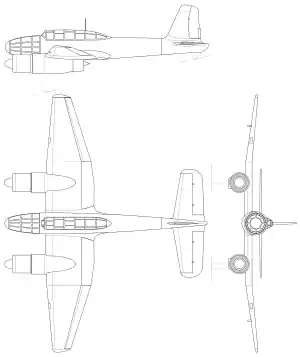Varga RMI-1 X/H
The Varga RMI-1 was a twin-engine turboprop-powered aircraft designed by Hungarian engineer László Varga.[1] It was a fighter bomber intended to test the new turboprop Jendrassik Cs-1 aero engine. Only one prototype was built, as with the signing of a mutual defence pact between Hungary and Germany in June 1941 it was decided to license produce the Daimler-Benz DB 605 piston engine and purchase the Messerschmitt Me 210 fitted with these engines to fill the fighter bomber requirement. Due to difficulties with the original engines the sole prototype was re-engined with German Daimler-Benz DB 605s in 1944 and undertook taxiing trials and high speed runs, but was destroyed by Allied bombing in June 1944 before making its first flight.[2]
| RMI-1 X/H | |
|---|---|
 | |
| Role | Reconnaissance-bomber |
| National origin | Hungary |
| Manufacturer | RMI (Repülő Muszaki Intézet) |
| Designer | László Varga |
| First flight | not flown |
| Number built | 1 |
Design
The RMI-1 was a low wing twin engined with two turboprop engines slung under the wings. It was designed to have a crew of two or three. The tail plane was of the conventional type with a single vertical stabilizer.
Specifications (X/H)
Data from [1]
General characteristics
- Length: 12.74 m (41 ft 10 in)
- Wingspan: 15.7 m (51 ft 6 in)
- Height: 5.5 m (18 ft 1 in)
- Empty weight: 4,500 kg (9,921 lb)
- Gross weight: 6,500 kg (14,330 lb)
- Powerplant: 2 × Jendrassik Cs-1 turboprop, 750 kW (1,000 hp) each
Performance
- Maximum speed: 540 km/h (340 mph, 290 kn) estimated
References
- "RMI / Repülő Muszaki Intézet Varga RMI-1/ X / H". Retrieved 7 March 2017.
- "The Jendrassik CS-1: The World's First Turboprop Engine". www.tailsthroughtime.com. Retrieved 2017-03-05.